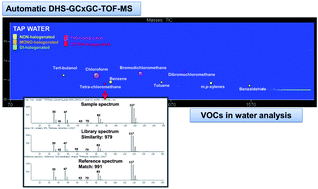This article describes an effective full scan new analytical approach for target and non-target screening of volatile organic compounds (VOCs) in water based on an automatic dynamic headspace (DHS) sampler followed by comprehensive two-dimensional gas chromatography time-of-flight mass spectrometry (GCxGC-TOF-MS). The operational parameters of DHS having influence on the extraction efficiency of water samples were optimized. The performance of a developed method by DHS-GCxGC-TOFMS was assessed with special attention to the capability of an enhanced separation and reliable identification at a trace concentration level in water. For this purpose, 31 target compounds including non-halogenated, mono-, di-, tri- and tetra-halogenated VOCs were selected. DHS-GCxGC-TOFMS allowed fast and automated analysis of VOCs at a level of parts per trillion, with no matrix interference in the different types of water analyzed (drinking water-tap, and bottled, river water and sea water) and with a minimum sample preparation. Excellent method detection and quantification limits were achieved, ranging from 0.01 to 10 ng L−1 and from 0.02 to 34 ng L−1, respectively. Good linearity (r2 > 0.99), intra and inter-day repeatability (<30%) were obtained for most of the target analytes denoting the suitability of the method for quantifying VOCs and its potential use in a routine setting. This method was successfully applied to real samples. Full mass range TOFMS acquisition allowed for positive identification of both targets, through mass spectral matching to database standards, and non-targeted compounds (dichloroiodomethane and dichloroacetonitrile). Trihalomethanes, tetrachloroethene, benzene, toluene ethylbenzene and xylenes (BTEXs) were the most frequently detected contaminants in the water samples analyzed. Mean concentrations of VOCs ranged from 65–439 ng L−1 in sea water, 29–1626 ng L−1 in bottled water, 17–16 312 ng L−1 in river water and 51–54 460 ng L−1 in tap water. The feasibility of using effective software data was very useful to rapidly sort information about the presence of VOCs in water and pattern recognition.


 Please wait while we load your content...
Please wait while we load your content...